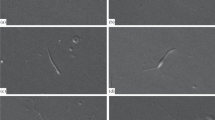Abstract
It was already shown that antifreeze glycoproteins isolated from the blood of fish occurring in circumpolar regions inhibited the growth of ice crystals both in vitro and in vivo. When the spermatozoa were frozen to liquid nitrogen temperature, addition of antifreeze glycoproteins to cryoconserving media made it possible to decrease twofold the concentration of the synthetic cryoprotector dimethylsulfoxide without the loss and even with a certain increase in the number of viable spermatozoa. This effect was observed in the case of combined, rather than separate, addition of the fraction of weakly active (low molecular weight) and active (high molecular weight) antifreeze glycoproteins. Here, we studied the effect of antifreeze glycoproteins on the survival of carp spermatozoa under storage at 4°C for varying periods of time. In the presence of total fraction of low and high molecular weight antifreeze glycoproteins (2 and 10 mg/ml) added in a physiological proportion (3 : 1), the survival of spermatozoa increase but this increase did not depend linearly on the medium concentration of protein. Low and high molecular weight antifreeze glycoproteins added separately (10 mg/ml) either did not affect or slightly affected the preservation of cells. The hypothermic effect of antifreeze glycoproteins in water was significantly higher than in a medium with salt activator.
Similar content being viewed by others
REFERENCES
Ahlgren, J.A., Cheng, C.C., Schrag, J.D., and DeVries, A.L., Freezing Avoidance and the Distribution of Antifreeze Glycopeptides in Body Fluids and Tissues of Antarctic Fish, Exp. Biol., 1988, vol. 137, pp. 549-553.
DeVries, A.L., Antifreeze Peptides and Glycopeptides in Cold-Water Fishes, Annu. Rev. Physiol., 1983, vol. 45, pp. 245-260.
DeVries, A.L., The Role of Antifreeze Glycopeptides and Peptides in the Freezing Avoidance of Antarctic Fishes, Comp. Biochem. Physiol., 1988, vol. 90B(3), 611-621.
Harrison, K., Hallett, J., Burcham, T.S., et al., Ice Growth in Supercooled Solutions of Antifreeze Glycoprotein, Nature, 1987, vol. 328, pp. 241-243.
Hew, C.L., Slaughter, D., Fletcher, G.L., and Joshi, S.B., Antifreeze Glycoproteins in the Plasma of Newfoundland Atlantic Cod (Gadus morhua), Can. J. Zool., 1981, vol. 59, pp. 2186-2192.
Hochachka, P. and Somero, D., Strategiya biokhimicheskoi adaptatsii (Strategy of Biochemical Adaptation), Moscow: Mir, 1977.
Karanova, M.V., Antifreeze Properties of Low Molecular Weight Glycoproteins from the Blood of Polar Fish, Biofizika zhivoi kletki (Biophysics of Living Cell), 1994, vol. 6, pp. 68-73.
Karanova, M.V. and Tsvetkova, L.I., Cooperative Properties of Antifreeze Glycoproteins upon Freezing of Fish Sperm, Izv. Ross. Akad. Nauk. Ser. Biol., 1994, no. 5, pp. 818-827.
Kopeika, E.F., Belous, A.M., and Pushkar', N.S., Cryoconservation of Fish Sperm, Aktual'nye problemy kriobiologii (Current Problems of Cryobiology), Kiev: Nauk. Dumka, 1981, pp. 281-299.
Lowry, O.H., Rosebrough, N.J., Farr, A.L., and Rendal, R.T., Protein Measurement with the Folin Phenol Reagent, J. Biol. Chem., 1951, vol. 193, pp. 265-271.
Mezhevikina, L.M. and Karanova, M.V., Use of Antifreeze Glycoproteins upon Freezing of Early Murine Embryos in Liquid Nitrogen, Izv. Ross. Akad. Nauk. Ser. Biol., 1995, no. 2, pp. 172-177.
Osuga, D.T., Ward, F.C., Yeh, Y., and Feeney, R.E., Cooperative Functioning between Antifreeze Glycoproteins, J. Biol. Chem., 1978, vol. 253, pp. 6669-6672.
Rubinsky, B., Arav, A., Mattioli, M., and DeVries, A.L., The Effect of Antifreeze Glycoproteins on Membrane Potential Changes at Hypothermic Temperatures, Biochem. Biophys. Res. Commun.,1990, vol. 173, no. 3, pp. 1369-1374.
Shumskii, P.A., Osnovy strukturnogo ledovedeniya (Foundations of Structural Ice Studies), Moscow: Akad. Nauk SSSR, 1955.
Sinyukov, V.V., Struktura odnoatomnykh zhidkostei, vody i vodnykh rastvorov elektrolitov (Structure of Monatomic Fluids, Water, and Aqueous Solutions of Electrolytes), Moscow: Nauka, 1976.
Yang, D.S.C., Sax, M., Chakrabartty, A., and Hew, C.L., Crystal Structure of an Antifreeze Polypeptide and Its Mechanistic Implications, Nature, 1988, vol. 333, pp. 232-237.
Author information
Authors and Affiliations
Rights and permissions
About this article
Cite this article
Karanova, M.V., Pronina, N.D. & Tsvetkova, L.I. The Effect of Antifreeze Glycoproteins on Survival of Fish Spermatozoa under the Conditions of Long-Term Storage at 4°C. Biology Bulletin 29, 75–79 (2002). https://doi.org/10.1023/A:1013298003947
Issue Date:
DOI: https://doi.org/10.1023/A:1013298003947




